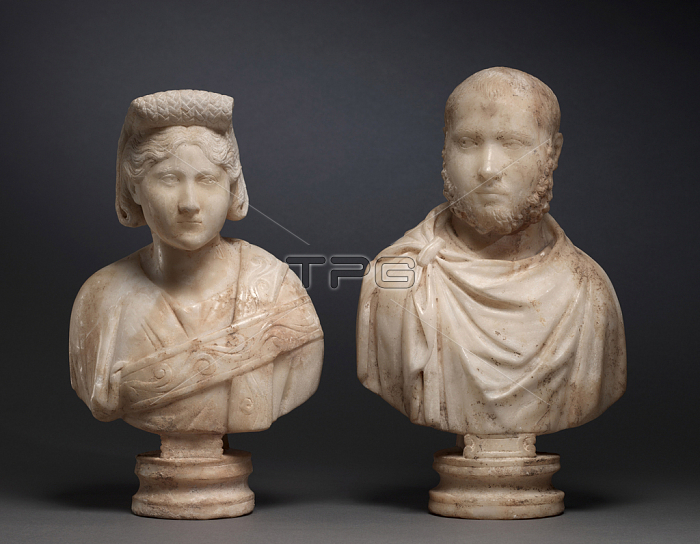
499618 Portrait Bust of an Aristocratic Man and Portrait Bust of an Aristocratic Woman, c.270-280 (marble) by Roman Imperial Period (27 BC-476 AD); 35.2x21.5x12 wt:15.5 lbs (man) cm; Cleveland Museum of Art, OH, USA; (add.info.: These busts are thought to have been unearthed with the Good Shepherd and Jonah sculptures displayed nearby. The nearly identical facial characteristics of each sitter-three males and three females-suggest that the same man and woman was represented three times. Although the intended function of the busts remains unknown, they probably represent a husband and wife. The portraits have been dated stylistically, as well as by costume and hairstyle, to the 270s ad. One of the men wears a paludamentum, or fringed cloak. One of the women wears a decorative stole, an attribute of rank probably conferred on her by her husband. The most distinctive feature of the female portraits is the hairstyle, a variation of the scheitzelkopf, in which the hair, after being combed behind the ears down to the nape of the neck, is braided, pulled up over the top of the head and folded under at the front. Careful study of the evolution of women\'s coiffures supports a date of 270 to 280 ad for the portraits, about the same as the symbolic sculptures of Jonah and the Good Shepherd. The rarity of intentionally paired portrait busts in late antiquity, especially those in a series, raises questions as to their original function. The busts may have been commemorative and intended for distribution as diplomatic gifts. It is likely that they were commissioned by a single, important patron or family to enhance their social or political status. ); John L. Severance Fund; out of copyright.
| px | px | dpi | = | cm | x | cm | = | MB |
Details
Creative#:
TOP27095597
Source:
達志影像
Authorization Type:
RM
Release Information:
須由TPG 完整授權
Model Release:
No
Property Release:
No
Right to Privacy:
No
Same folder images:

 Loading
Loading